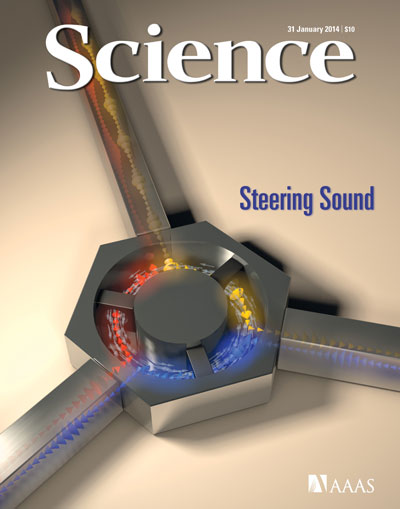First one-way acoustic circulator lets you hear without being heard
January 31, 2014

A one-way circulator for sound. The arrows represent acoustic signals flowing through the device (diameter: ~20 centimeters), which circulates sound in a nonreciprocal fashion: signals can flow from left to top, from top to right, and from right to left, but not in the opposite directions. This creates one-way communication channels for sound, allowing listeners to hear but not be heard in return. (Credit: Erik Zumalt, Cockrell School of Engineering, UT Austin)
A team of researchers at The University of Texas at Austin’s Cockrell School of Engineering has built the first-ever one-way circulator for sound.
The team’s experiments successfully prove that the fundamental symmetry with which acoustic waves travel through air between two points in space (“if you can hear, you can also be heard”) can be broken by a compact and simple device.
“Imagine being able to listen without having to worry about being heard in return,” said Andrea Alù, who led the project and is an associate professor and David & Doris Lybarger Endowed Faculty Fellow in the Cockrell School’s Department of Electrical and Computer Engineering.
The scientific knowledge gained from successfully building a nonreciprocal sound circulator may lead to advances in noise control, new acoustic equipment for sonars and sound communication systems, and improved compact components for acoustic imaging and sensing.
The design
An electronic circulator, typically used in communication devices and radars, is a nonreciprocal three-port device in which microwaves or radio signals are transmitted from one port to the next in a sequential way. When one of the ports is not used, the circulator acts as an isolator, allowing signals to flow from one port to the other, but not back.
The UT Austin team realized the same functionality is true for sound waves traveling in air.*
“It is just the right spin of fluid (air) coupled with the strong resonance of our ring cavity, which makes our design powerful,” Alù said. “These two combined mechanisms create strong nonreciprocity in a compact device. Sound waves are routed in one direction only — always contrary to the direction of the airflow.”

(A) Photograph of the fabricated cavity (without the top cover). The ring cavity is biased by using three low-noise fans connected to a current source. (B) Photograph of the fabricated device. The biased cavity is closed and connected to three acoustic waveguides. (Credit: Romain Fleury et al./Science)
“More broadly, our paper proves a new physical mechanism to break time-reversal symmetry and subsequently induce nonreciprocal transmission of waves, opening important possibilities beyond applications in acoustics,” Alù said. “Using the same concept, it may actually be possible to construct simpler, smaller and cheaper electronic circulators and other electronic components for wireless devices, as well as to create one-way communication channels for light.”
This research may eventually allow for an “acoustical version of one-way glass,” said Preston Wilson, acoustics expert and associate professor in the Department of Mechanical Engineering. “It also opens up avenues for very efficient sound isolation and interesting new concepts for active control of sound isolators.”
The UT Austin team believes their basic design for this first-of-its-kind sound circulator can be easily scalable to different acoustic frequencies. UT Austin has filed a provisional patent on the device.
Alù and his team are now working on a design for the sound circulator that does not require moving parts. In a parallel research line, they are also working on translating these concepts to realize novel nonreciprocal components, such as circulators and isolators, for radio waves and light.
Research for the acoustic circulator was supported by the Defense Threat Reduction Agency and the Air Force Office of Scientific Research.
* At the core of the team’s sound circulator is a resonant ring cavity loaded with three small computer fans that circulate the airflow at a specific velocity. The ring is connected to three ports outfitted at each end with microphones that record sound. In their experiment, the researchers start by transmitting sound from one port, for example, Port 1. If the fans are off, the sound signal from Port 1 splits symmetrically into the two receiving ports, Port 2 and Port 3, as expected. However, when the researchers turned the fans on and delivered a moderate airflow into the ring, with specific velocity tailored to the ring design, transmission symmetry was broken and the signal from Port 1 would flow entirely into Port 2, leaving Port 3 completely isolated. Conversely, when a signal was sent from Port 2, it would flow into Port 3, leaving Port 1 isolated. Acoustic signals then flow from Port 1 to Port 2, from Port 2 to Port 3 and from Port 3 to Port 1, but not in the opposite directions (see figure).
Abstract of Science paper
Acoustic isolation and nonreciprocal sound transmission are highly desirable in many practical scenarios. They may be realized with nonlinear or magneto-acoustic effects, but only at the price of high power levels and impractically large volumes. In contrast, nonreciprocal electromagnetic propagation is commonly achieved based on the Zeeman effect, or modal splitting in ferromagnetic atoms induced by a magnetic bias. Here, we introduce the acoustic analog of this phenomenon in a subwavelength meta-atom consisting of a resonant ring cavity biased by a circulating fluid. The resulting angular momentum bias splits the ring’s azimuthal resonant modes, producing giant acoustic nonreciprocity in a compact device. We applied this concept to build a linear, magnetic-free circulator for airborne sound waves, observing up to 40-decibel nonreciprocal isolation at audible frequencies.
